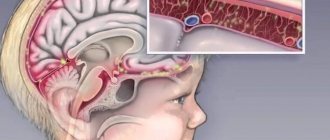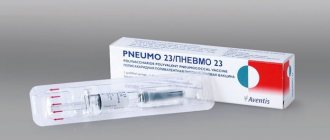Compound
As part of the Pentaxim vaccine, which is available in the form of a suspension: toxoids (toxoids) of diphtheria (Diphtheria), tetanus (Tetanus) and whooping cough (Pertussis) are present in a concentration of ≥ 30 IU/≥40 IU/25 μg/dose, respectively.
The concentration of filamentous hemagglutinin in one dose is 25 mcg of Filamentous hemagglutinin. The concentration of inactivated polio type 1-3 in ELISA units is, respectively, 40, 8 and 32 IU*.
The absorption and effect of the active components are optimized by the excipients included in Pentaxim: formaldehyde , aluminum hydroxide, Hanks medium 199*, sodium hydroxide or acetic acid, phenoxyethanol , water d/i.
*The suspension does not contain phenol red.
The vaccine for the prevention of diseases caused by HIB contains HIB polysaccharide conjugated with tetanus toxoid at a concentration of 10 μg/dose, as well as trometamol and sucrose.
What analogues of vaccination are produced in foreign countries?
There are many foreign-made combination drugs that allow you to instill immunity against the most dangerous infections and can be used as a replacement for Pentaxim:
- Infanrix is a combined vaccine solution containing components against whooping cough, diphtheria and tetanus (the most popular analogue of Pentaxim for preschool children, which is produced in the UK);
- Daptacel . French vaccine containing diphtheria and tetanus toxoids, as well as acellular pertussis suspension (recommended for vaccination of children under 7 years of age);
- Kinrix or a quadrivalent vaccine, including diphtheria and tetanus toxoid, fragments of killed whooping cough cells and an anti-polio component (used in children from 4 to 6 years old);
- Pediatrix is a 5-in-1 combination vaccine containing diphtheria and tetanus toxoids, as well as pertussis proteins, recombinant and inactivated poliovirus vaccines against hepatitis B (for children under 7 years of age);
- Adacel or trivalent vaccine from the French company Sanofi Pasteur, which includes diphtheria and tetanus toxoids, as well as pertussis suspension (intended for children over 11 years of age and adults);
- Boostrix, produced in England, is intended for patients over 10 years of age and protects against three infections at once, namely diphtheria, tetanus, whooping cough;
- ActHIB is a vaccine against Haemophilus influenzae, tetanus, diphtheria, whooping cough (used in patients of all ages, starting from 10 years).
Release form
Pentaxim vaccine for immunization against diphtheria (Diphtheria) and tetanus (Tetanus), adsorbed, pertussis (Pertussis), acellular, and polio (Poliomyelitis), inactivated, is a cloudy, whitish suspension. Intended for intramuscular administration, it is available in 0.5 ml doses in 1 ml glass syringes (the syringe can come with or without a fixed needle).
The vaccine for the prevention of diseases caused by HIB is a homogeneous, white, lyophilized mass for the preparation of a suspension for intramuscular administration. Available in glass bottles, 1 dose per bottle.
Each cardboard package is equipped with one bottle of lyophilisate and one glass syringe with a suspension, placed in a closed cell packaging.
In the case when the syringe comes without a needle, the delivery set additionally includes 2 separate sterile needles, sealed in cell packaging.
Pharmacodynamics and pharmacokinetics
The Pentaxim vaccination is designed to vaccinate children against tetanus (Tetanus), diphtheria (Diphtheria), polio (Poliomyelitis), whooping cough (Pertussis) and diseases caused by Haemophilus influenzae (including against septicemia , meningitis , epiglotitis , pneumonia , etc.) . If the timing of revaccination is observed, the vaccinated child develops lasting immunity to these diseases.
The manufacturer of Pentaxim did not provide data regarding the pharmacokinetics of the drug.
Pentaxim is well tolerated and is recommended for use in children over three months of age.
It must be taken into account that the drug does not contribute to the formation of immunity against diseases caused by other serotypes of Haemophilus influenzae (A, C, D, E and F) , as well as immunity to meningitis provoked by other pathogenic microflora .
Indications for use: Pentaxim vaccination - what is it for?
Pentaxim is used for the prevention in children from 3 months to 47 months 29 days of tetanus (Tetanus), diphtheria (Diphtheria), poliomyelitis (Poliomyelitis), whooping cough (Pertussis) and invasive infections caused by HIB (including meningitis and septicemia ).
The drug can be used for primary vaccination of children over one year of age for the prevention of tetanus (Tetanus), diphtheria (Diphtheria), polio (Poliomyelitis), whooping cough (Pertussis) and invasive infections caused by HIB. If a child older than 12 months has not previously been vaccinated against these diseases, it is recommended to administer Pentaxim suspension exclusively.
Also, using Pentaxim, it is possible to vaccinate and revaccinate children who have previously been immunized with several doses of whole-cell or acellular vaccine against tetanus (Tetanus), diphtheria (Diphtheria) and whooping cough (Pertussis), subject to ongoing vaccination/booster vaccination against polio .
Vaccination scheme
The course of primary vaccination consists of 3 doses of vaccine and revaccination. Immunization schedule: first administration, then the second after 45 days from the first, then the third after 45 days from the second and revaccination a year after the third is completed. The use of the vaccine is not clearly related to age. It is important to comply with vaccination dates. If the deadlines are extended, vaccination will not be resumed.
Violation of the vaccination schedule can lead to a decrease in the intensity of immunity to the components of the vaccine. The hemophilic component of the Pentaxim vaccine for children over one year of age is administered once. Therefore, as soon as a child over one year old is injected with the Pentaxim vaccine with a hemophilus influenzae component, it is the last one for immunization against hemophilus influenzae infection. Further prevention of diphtheria, whooping cough, tetanus and polio with the Pentaxim vaccine in a child older than one year is carried out without the use of the hemophilic component.
Contraindications
Contraindications to the administration of the Pentaxim vaccine are:
- known hypersensitivity to the components of the drug, as well as streptomycin , polymyxin B , glutaraldehyde , neomycin .
- Progressive organic brain lesions (including those accompanied by seizures).
- Organic brain lesions that developed within 7 days after administration of a vaccine containing (Bordetella pertussis) antigens
- History of a strong reaction to administration of a vaccine containing a pertussis component The reaction is associated with vaccination if it occurs within 48 hours of injection. As a rule, it is expressed in the form of increased body temperature, febrile and afebrile convulsions , prolonged unusual crying syndrome, decreased muscle tone with simultaneous neurological pathology .
- History of allergic reactions to vaccination against tetanus (Tetanus), diphtheria (Diphtheria), polio (Poliomyelitis), whooping cough (Pertussis) and invasive infections caused by HIB.
- Acute infectious diseases , diseases that are accompanied by hyperthermia , as well as aggravated chronic diseases (in these cases, the child should be vaccinated only after a period of remission of the chronic disease or complete recovery).
It is recommended to vaccinate with Pentaxim with caution:
- children who have previously experienced generalized seizures against a background of high (more than 38.5°C) temperature. The condition of such patients is carefully monitored for 48 hours after administration of the drug, and in the event of an increase in body temperature, they are prescribed to take antipyretics of hyperthermia .
- Children with a history of hypersensitivity reactions to any vaccine. In addition, the doctor should be informed by the parents of any of allergic reactions to vaccines.
- Children with hemocoagulation (for example, thrombocytopenia ), since intramuscular injection in them is associated with a high risk of bleeding.
In patients who are being treated with immunosuppressants , as well as in patients with impaired immunological reactivity, the response to the Pentaxim vaccine may be reduced.
If the patient has a history of indicating the development of acute polyradiculitis or plexitis in response to vaccination with drugs that contain a tetanus component , the physician should carefully weigh the benefits and potential risks of immunization with Pentaxim. In such cases, completion of primary immunization is usually considered justified.
Quality control
How does the quality control department work at ? The laboratories are equipped with a computer system to which all the equipment used to test products is connected. The results of all tests immediately go there and this “primary data” can no longer be deleted. If suddenly during the release control process it turns out that something is wrong with a batch of vaccine, it will be impossible to hide it. In addition, samples from each series are archived. They will be needed for investigation if the vaccine is suddenly suspected of causing harm. And they are stored for the entire shelf life of the vaccine!
Side effects
The administration of Pentaxim can cause side effects of both local and systemic nature.
The most common local reactions: redness, soreness (usually expressed by short-term crying at rest or after lightly pressing the skin at the injection site) and the appearance of a lump at the injection site (in approximately 0.1-1% of cases, the diameter of the lump after vaccination exceeds 5 cm). The described side effects may develop within 48 hours after the injection.
Systemic reactions to vaccination in a child are expressed in the form of: hyperthermia (in 1-10% of cases the child’s body temperature exceeds 38°C, in 0.1-1% of cases it is more than 39°C, in 0.01-0.1% of cases - more than 40°C), drowsiness, irritability, anorexia, sleep disturbances, vomiting, diarrhea, prolonged crying.
Extremely rare side effects of the Pentaxim vaccine are skin rashes, urticaria , hypotension , febrile/afebrile convulsions , anaphylactoid-type reactions (shock, Quincke's edema) , hypotonic-hyporeactive episode .
Sometimes the administration of a vaccine that contains a HIB component is accompanied by cases of swelling of the lower extremities (one or both at the same time, with the limb on the side where the drug was administered swelling much more).
Swelling is observed mainly in the first few hours after primary vaccination. In some cases, reactions of this type occur with hyperthermia , prolonged crying, pain, changes in skin color (including the appearance of a bluish color), petechiae , redness of the skin, transient purpura , and rash are observed somewhat less frequently.
The described symptoms were not associated with any adverse events from the respiratory system or heart and disappeared spontaneously within 24 hours without any residual effects.
In very rare cases, the presence of an acellular pertussis component provoked severe reactions at the injection site (more than 5 cm in diameter), including tissue swelling extending to one or both joints at the same time.
These reactions appeared 24-72 hours after vaccination and were sometimes accompanied by local hyperthermia (at the injection site), pain or sensitivity, and redness of the skin.
Side effects disappear within 3-5 days and do not require special treatment.
Presumably, the likelihood of their development depends on the number of administrations of the acellular pertussis component (that is, the risk of their occurrence increases significantly after the fourth and fifth doses of such a vaccine).
There is evidence that the administration of other vaccines containing tetanus toxoid was accompanied by brachial neuritis and acute polyradiculitis .
You should inform your doctor about all adverse reactions to the administration of Pentaxim (including those not listed in the instructions).
Analogs of Russian-made Pentaxim
The most famous domestic analogue of the Pentaxim vaccine is the Russian DTP vaccine . This suspension refers to a combined solution, which includes diphtheria and tetanus toxoids, as well as a pertussis component.
DPT vaccine
The last component is dead cells of whooping cough pathogens, which is why it differs from its foreign analogues, which do not include cellular elements, but only their protein fragments. According to the recommendations, the course of DTP vaccination consists of three injections of the drug given at intervals of 1-2 months, and revaccination at 18 months.
Unfortunately, Pentaxim of French origin is almost impossible to find in domestic pharmacies today. This is due to the fact that since 2016, Russian-made Pentaxim, created on the basis of the Kirov production complex and fully meeting all the standards of a foreign vaccine, has been supplied to clinics.
Vaccine Pentaxim: instructions for use
The drug is intended for intramuscular administration. It is prohibited to administer the vaccine subcutaneously or intravenously.
Single dose - 0.5 ml. The injection is made into the middle third of the anterolateral thigh. Before injecting the suspension, you must make sure that the needle does not enter a blood vessel.
If you are using a package that comes with two separate sterile needles, the needle must be tightly secured by turning it ¼ turn relative to the syringe before preparing the vaccine.
To prepare the vaccine, you must first remove the plastic colored cap from the bottle, then completely introduce the suspension for intramuscular administration through a needle from a syringe into a bottle with lyophilized mass (vaccine for the prevention of HIB infections).
Without removing the syringe, shake the bottle and wait until the lyophilized mass is completely dissolved (no more than 3 minutes). The resulting suspension is cloudy and has a whitish tint. If the substance has changed color or contains foreign impurities, it is prohibited to use it.
The finished vaccine is completely drawn into the same syringe and immediately administered to the child.
The instructions for Pentaxim indicate that the course of immunization with the drug involves administering 3 doses of the vaccine to the child with an interval of 30-60 days. Vaccination begins when the baby reaches three months of age, revaccination is carried out by administering one dose of the drug at the age of 18 months.
If the vaccination schedule is violated, the intervals between administration of the second and third doses of the drug do not change, as does the interval before the revaccination dose (it is 12 months).
If vaccination begins at the age of six months to a year, the second dose is administered 1.5 months after the first, and as a third dose, which is administered 1.5 months after the second, it is necessary to use a suspension for the prevention of tetanus , polio , whooping cough and diphtheria . originally presented in a syringe (that is, there is no need to dilute the lyophilized mass in a bottle).
For revaccination in this case, the usual dose of the drug Pentaxim is used with a dilution of the lyophilisate with the polysaccharide HIB conjugated to tetanus toxoid .
If the first vaccination is given to a child older than 12 months, then for each subsequent dose (including revaccination), a suspension is used to prevent tetanus , polio , whooping cough and diphtheria , initially presented in a syringe (without diluting the lyophilized mass in a vial (HIB)).
- 1st vaccination - the full drug with the HIB component is administered;
- The 2nd vaccination is carried out 1.5 months after the first vaccination - the full drug with the HIB component is administered;
- The 3rd vaccination is carried out up to six months after the first vaccination - the full drug with the HIB component is administered, if later - only a suspension from a syringe is administered, without diluting the lyophilisate (HIB);
- revaccination is carried out up to a year after the first vaccination - the full drug with the HIB component is administered, after a year - only a suspension from a syringe is administered, without diluting the lyophilisate (HIB).
In all cases of violation of the child’s immunization schedule, the doctor’s actions must be regulated by the appropriate vaccination calendar.
special instructions
To prevent possible adverse reactions (including hypersensitivity reactions), the doctor must assess the child’s health and medical history, check the medical history of his immediate family (including allergy) and immunization history, and clarify cases of side effects after previous immunization.
When conducting vaccinations, the doctor is required to have tools and medications that may be necessary in the event of an allergic reaction .
For children taking immunosuppressants , vaccination should be postponed until the end of treatment or remission of the disease. for parents of children with chronic immunodeficiency , even though the immune system may be weak.
How it works
The plant is a whole complex consisting of several buildings.
At the same time, everything is arranged very conveniently: to move from one building to another, you don’t need to go outside - there is a connecting corridor running along all the buildings.
In the visualization above you can see all the buildings:
No. 1 - warehouse for raw materials and supplies; No. 2 - Administrative building, quality control laboratory;
No. 3 - Production of solid dosage forms; No. 4 - Production of vaccines and genetically engineered drugs; No. 5.
Reserve Corps. Antonina's tour began from building No. 2, where the entire floor is occupied by the quality control service. 120 people work here (which is almost half of all plant employees). The service consists of several laboratories:
- microbiological laboratory
(here everything that goes into production and everything that is released - the final product - is checked for sterility); - biochemical laboratory
(here the concentration of adjuvant and antigens in the vaccine is checked); - chemical analytical laboratory
(here tests are carried out to control the level of formaldehyde and 2-phenoxyethanol in vaccines).
The plant does not have its own vivarium (room for keeping laboratory animals). Therefore, such tests are carried out outsourced.
Analogs
Level 4 ATX code matches:
Tetraxim
Infanrix Hexa
Infanrix
The same pharmacological group with the Pentaxim vaccine includes the drugs Bubo-Kok , Bubo-M , DTP vaccine , DTP-M , DPT-Hep-B vaccine , Infanrix , Infanrix Hexa , Tetraxim , Infanrix Penta .
DTP or Pentaxim - which is better?
The drug Pentaxim contains antigens of tetanus and diphtheria toxoids , components of the cell walls of Bordetella pertussis (the causative agent of whooping cough ), inactivated polio virus types 1-3 and capsular polysaccharides HIB (Haemophilus influenzae serotype b).
The main difference between Pentaxim and the whole-cell DTP vaccine is the method of its preparation, due to which the vaccine is characterized by lower reactogenicity in comparison with its analogue.
Which is better - DTP or Pentaxim?
To this question, doctor Komarovsky E.O. answers that the acellular pertussis component of the Pentaxim vaccine allows the baby to more easily endure the post-vaccination period, while the child suffers much less often from pain at the injection site and fever.
Another “advantage” of Pentaxim is that this vaccine makes it possible to immunize a child against 5 diseases in 4 injections.
Pentaxim or Infanrix - which is better?
Which is better - Pentaxim or Infanrix ? Which is better Pentaxim or Infanrix Hexa ? Such questions worry almost all young parents who are faced with vaccination for the first time.
Most often, doctors suggest vaccinating a child with DTP , or Pentaxim, or Infanrix. These preparations differ from each other in the number of components and the degree of their purification.
The DTP vaccine allows a child to develop immunity to whooping cough , tetanus and diphtheria (it contains a suspension of dead microbes Bordetella pertussis, as well as purified tetanus and pertussis toxoids ). The DTP-Hep-B vaccine is a four-component drug that promotes the development of immunity to whooping cough , tetanus , diphtheria and hepatitis B.
The Infanrix vaccine comes in three-, four-, five- and six-component versions: the Infanrix three-component suspension is used to prevent diphtheria , whooping cough and tetanus ; the four-component suspension Infanrix IPV allows the child to additionally develop immunity to polio ; The five-component Infanrix Penta is used to prevent 3 of these diseases, polio and hepatitis B ; Infanrix Hexa - for the prevention of 3 specified diseases, polio, hepatitis B and HIB infections .
Unlike the whole-cell vaccine DTP , Pentaxim and Infanrix are acellular drugs that contain only fragments of disease antigens. Comparing reviews from parents whose children were immunized with DPT and acellular vaccines , we can conclude that the latter are much better tolerated and cause fewer side effects.
To the question “Which is better - Pentaxim or Infanrix ?”, Komarovsky E.O. answers that both vaccines are high-quality products with highly purified components.
Infanrix wins here , since the pertussis component is present in it in the most split form. This has an impact on the effectiveness of vaccination, but it can significantly reduce not only the severity, but also the likelihood of adverse reactions.
Pentaxim or Tetraxim?
The drugs Tetraxim and Pentaxim are produced by the same manufacturer. Tetraxim vaccine and Pentaxim is the absence of the HIB component.
In cases where parents, in accordance with the individual vaccination schedule, do not need to vaccinate their child against hemophilus influenzae , the use of the Tetraxim vaccine allows them not to overpay for the unused hemophilus influenzae component.
Compatibility with other vaccines
The Pentaxim vaccine can be administered simultaneously with all drugs from the national calendar of preventive vaccinations on the same day, in different parts of the body, with the exception of the BCG vaccine. The use of the Pentaxim vaccine together with other vaccinations does not affect their immunogenicity (ability to develop immunity). Tolerability of vaccines does not deteriorate, and the number of adverse reactions does not increase. Pentaxim can be used to continue and complete a course of vaccination started with other vaccines against whooping cough, diphtheria, tetanus, polio and Haemophilus influenzae.
Administering several vaccines on the same day does not place an excessive burden on the immune system. All vaccines in the Russian national vaccination calendar are interchangeable.
Reviews of Pentaxim
Reviews about the Pentaxim vaccine are overwhelmingly positive. Reviews from doctors indicate that the drug is well tolerated by children, causes adverse reactions DTP
Commenting on the rare negative reviews about Pentaxim, doctors emphasize that each child’s body is individual, and it is impossible to predict its reaction to the vaccine. The guarantee that immunization will be easy for a child is the quality of the vaccine preparation, the child’s health condition and the conditions of vaccination.
Komarovsky E.O. in his blog he writes that vaccination is well tolerated by healthy children who lead a normal lifestyle, that is, children who walk enough, do not overeat, receive complementary foods in a timely manner (not too early), etc. In the case where parents violate the basic principles of care, vaccination can be a blow to a weakened immune system , and the child’s body reacts violently to it.
For parents who vaccinated their children with the Pentaxim vaccine, the main advantages of the drug are its effectiveness, excellent tolerability (in most cases, the post-vaccination period is asymptomatic), the ability not to give unnecessary injections, and in 4 injections to immunize simultaneously against 5 infections (for comparison, Infanrix, which is also well tolerated by children, allows you to develop immunity to only 3 diseases).
The disadvantages of the drug, according to most mothers, are its high price and the frequent lack of vaccine in many pharmacies and vaccination centers.
Pentaxim price
The price of the Pentaxim vaccine in Ukrainian pharmacies is 550-556 UAH. The price of vaccination in Russian pharmacies is 1260 rubles.
You can buy Pentaxim in Moscow and other large cities in a regular pharmacy, or through online pharmacies. However, in this case, the conditions for transportation and storage of the drug may be violated (failure to comply with the cold chain is detrimental to the vaccine).
For this reason, in treatment rooms, to eliminate the possibility of side effects, doctors refuse to vaccinate children with drugs brought by their parents if they are not available and advise them to go to commercial vaccination centers.






